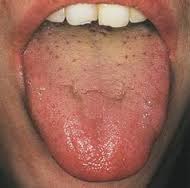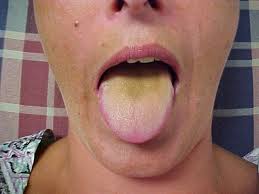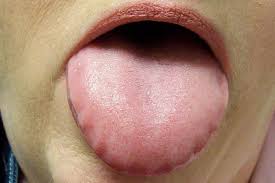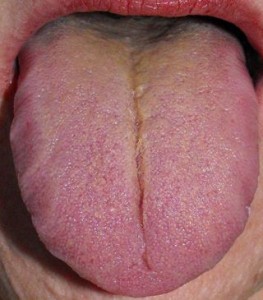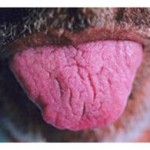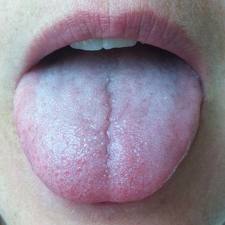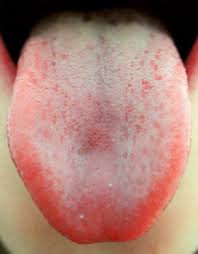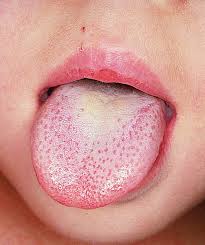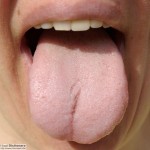Svastha Ayurveda
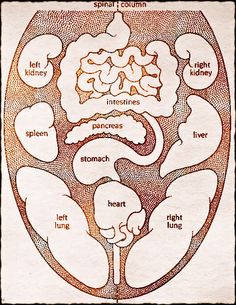 The tongue, according to Ayurveda, is a strong diagnostic tool for looking at one’s systemic health. It is a very accurate view into the inner health of an individual. Tongue analysis can be used in complement with pulse, nail, and facial diagnosis in order to really see what is going on internally and detect issues that may not have manifested otherwise.
The tongue, according to Ayurveda, is a strong diagnostic tool for looking at one’s systemic health. It is a very accurate view into the inner health of an individual. Tongue analysis can be used in complement with pulse, nail, and facial diagnosis in order to really see what is going on internally and detect issues that may not have manifested otherwise.
Although this technique is typically used by Ayurvedic practitioners and other Eastern healers, it is simple enough to do a self-diagnosis, even with an Ayurvedic newbie! Although not everything will always show up on the tongue, more often than not it does.
It is important to regularly check your tongue in order to recognize when your body is accumulating toxins, when foods are causing negative reactions to your system, or when other indications of disorder may arise.
Areas Covered with Tongue Diagnosis
- Organ health
- Vata, Pitta or Kapha imbalances
- Presence of toxins and where they are accumulating
- Tension and emotions held in the spine, shoulders, or organs
- Thyroid disorder
- Anemia
- Malabsorption of nutrients
- Parasitic infection
- Inflammation in the body
Basically, each area of the tongue is related to a certain organ in the body. As you can see in the picture above, the front of the tongue is related to the lungs and heart; the middle with the liver, spleen, and stomach; and the back with the kidneys, small intestine, and the colon. The very tip of the tongue correlates with the thyroid, and vertically, smack in the middle of the tongue, reveals the spine.
Tongue Abnormalities and What They Mean
Tongue Coating and Location:
If the tongue has any sort of coating on it, this is a very clear indication of toxic build-up in the system and poor overall digestion. The most common area where coating is typically found is on the back of the tongue, revealing that the toxic build-up is in the colon area. If you see a coating on a different area of the tongue, then that would indicate toxic build-up in the corresponding organ. If the entire tongue is coated, this indicates systemic toxins, meaning the toxins are in the bloodstream and invading the entire body.
Tongue Coating and Color:
The first line of action is to discover if there are toxins and their location (see above). After that, if you wish to dive deeper into diagnosis, you can look at the color of the coating which will reveal the doshic imbalance that are involved. If the coating is grey, black, or brown, you can assume Vata toxins; if the coating is orange, reddish, yellow, or green, this indicates Pitta toxins; and finally, if there is a thick, whitish coating, you can think Kapha toxins. This can be quite helpful as each toxin should be treated differently depending on which dosha is involved.
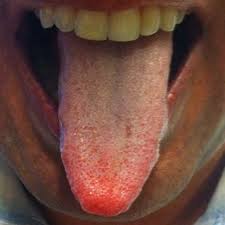
Vata Imbalance:
If a tongue is a so-called “Vata tongue”, it is typically small, thin, and shaky or trembling in appearance. It may look pale in color, appear to be dried out, and have a few (or many) cracks. Once again, if there is a coating it will be grey, blackish, or brown in color and will typically coat the colon area of the tongue. This is a storybook picture of a tongue revealing a Vata imbalance. Vata imbalances typically manifest as anxiety, fear, worry, restless mind, sleep issues, constipation, gas, bloating, and dryness.
Read more on How to Balance Vata here.
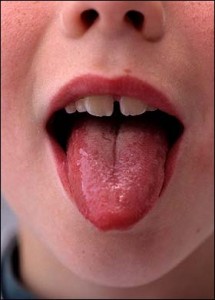
Pitta Imbalance:
If a tongue is of a Pitta nature, it may be medium in size, have a sharp or pointy tip, and be excessively red in color. There may also be red dots on the top of the tongue which reveals excessive heat in the blood. If there is a coating on the tongue, it will be green, yellow, or orange in color. The coating will typically be located in the small and large intestine area, the liver area, or may also be on the entire tongue revealing toxins in the bloodstream. Pitta imbalances manifest as inflammation, heat, skin disorders (psoriasis, eczema, acne, etc.), anger, irritation, hyperacidity, loose stools, and headaches.
Read more on How to Balance Pitta here.
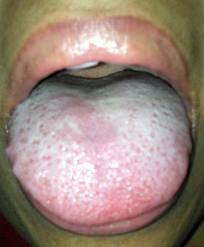
Kapha Imbalance:
A tongue revealing a Kapha imbalance tends to be large, thick, and heavy by nature. It may appear swollen, pale in color, and have thick saliva build-up. If there is a coating on a Kapha imbalanced tongue, the color of the coating usually will be whitish, thick, and mucusy. The coating may be located in the colon, the kidney area, the lung area, and/or the stomach area revealing increased Kapha in these organs. Symptoms of a Kapha imbalance include heaviness (both objective and subjective), congestion, grief, sadness, depression, lethargy, excessive sleep, day sleeping, slow metabolism, slow digestion, and easy weight gain.
Read more on How to Balance Kapha here.
Teeth Marks Around the Perimeter of the Tongue:
Unfortunately, it is quite common to see indentation marks along the outside perimeter of the tongue. This is a classic indication that there is malabsorption in the body of essential nutrients. Malabsorption is a lack of ability for your body to absorb specific nutrients and has a wide range of causes. Some of these include poor digestion, inflammation in the GI tract, excessive toxins in the colon, intake of allergenic foods, chronic loose stools, or parasitical infection. Once this issue is removed, the teeth marks should disappear. In certain cases, however, these marks are due to a swollen tongue, revealing inflammation in the system (see below).
Discover the Ayurvedic treatment of Malabsorption here.
Crack, Vertically Down the Center of the Tongue:
This vertical line, that may be located down the center of the tongue, is an indication that there are stresses and emotions being held in the spine. The top of the spine area (cervical spine) correlates to the tip of the tongue and the lower spine (lumbar spine) correlates to the back of the tongue. So, wherever the spine line manifests on the tongue reveals where the tension is being held. If there is any cracking along the spine, this indicates pain, tension, and misalignment at whatever point the crack corresponds to on the tongue/spine. This picture is an example of an individual with complete spinal tension with some misalignment in the neck area.
Many Cracks all Over the Tongue:
The appearance of multiple small cracks all over the tongue is a clear indicator of a strong, chronic Vata derangement such as high anxiety, fear, insomnia, and possibly a nervous system disorder. If the cracks are only located on one area of the tongue, this may reveal chronic high Vata in that correlating organ (i.e. Vata in the colon). Since the disorder is chronic, Vata pacification should be administered, although this may take some time to heal. Once healed, however, the cracks should begin to clear.
Read more on How to Balance Vata here.
Swollen Tongue:
A swollen tongue may be a sign of inflammation in the body indicating the presence of an allergen such as an undesirable food. This can also reveal a Kapha imbalance such as hypothyroidism or fluid retention as well. If one is suffering from a swollen tongue, more investigation should be administered in order to reveal the cause and begin to remove it.
Drooping in the Heart Area of the Tongue:
A hollowness or scooping around the center of the tongue is a common indicator that there is unresolved sadness, grief, or depression in the heart. This picture shows a clear depression in the heart, as well as systemic toxins, due to the coating, and excessive heat in the blood due to the red dots and red edges of the tongue. Each imbalance occurring in our system is often correlated with the other and, therefore, it is often necessary to look at the entire picture.
Red, Raised Papillae on the Top of the Tongue:
If you see these raised red dots on the surface of your tongue, this typically means there is excessive Pitta or heat in the plasma and blood. Typically, a tongue with these red dots will also be excessively red along the perimeter, confirming this increase in heat. Too much heat can result in loose stools, hyperacidity, ulcer, inflammation, headaches, excessive anger, or irritation. This can be resolved through cooling, Pitta balancing practices, and the appropriate dietary changes.
Read more on How to Balance Pitta here.
Pale Tongue:
A pale tongue is typically a sign of low red blood cells indicating possible anemia. This can be due to excessive blood loss (heavy menstruation or injury); an iron, folate, or B12 deficiency; ulcer; parasitical infection; certain medications (including NSAIDS); malabsorption; chronic diseases such a cancer, rheumatoid arthritis or HIV; or many different autoimmune conditions. Anemia can cause fatigue, weakness, poor circulation, frequent bruising, shortness of breath, irregular heartbeat, and cognitive issues. If anemia is suspected, one can look to see if other symptoms are involved, as well as the nails and the pink under the eye (when stretched down) to see if these areas are also pale.
Conclusion
So, there you have the most common attributes to look for in a self-tongue diagnosis along with what these different revelations may indicate for your health.
Make this analysis a part of your daily routine by peeking at the tongue each morning upon awakening. For the most accurate diagnosis, it is best to do this before brushing the teeth or scraping the tongue. The tongue may change day-to-day depending on our food choices, emotions, and overall health. This practice can often reveal the ingestion of allergenic foods, imbalance manifesting, or illness in its potential stage.
___
https://svasthaayurveda.com/ayurvedic-tongue-analysis-what-does-your-tongue-say-about-your-health/

